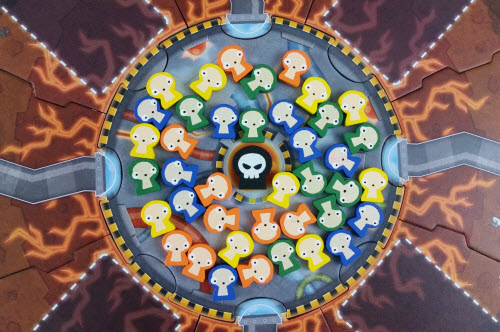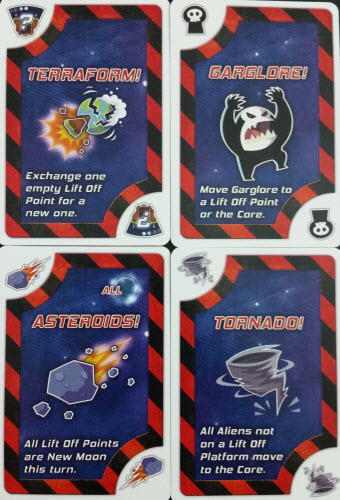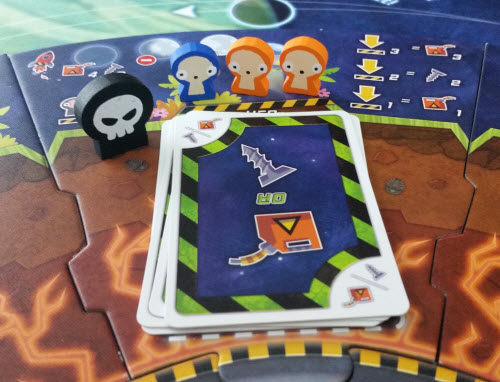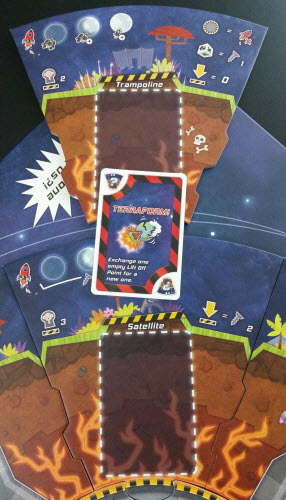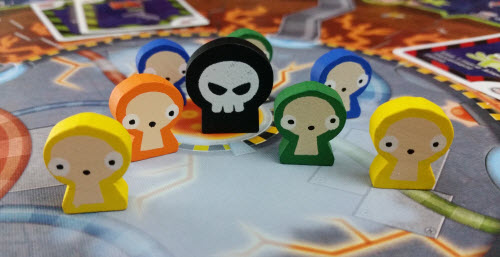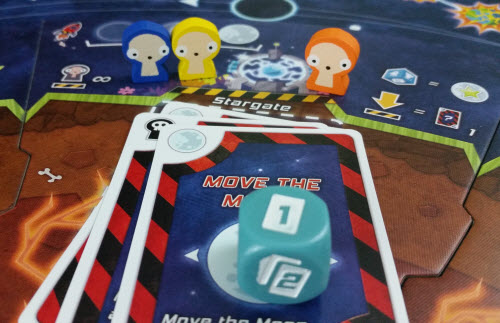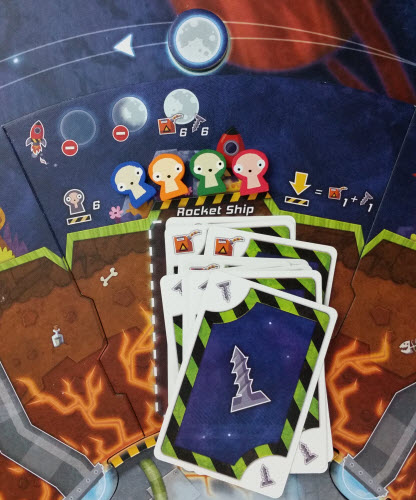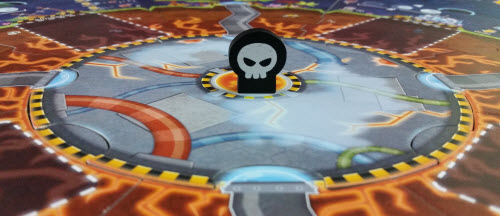Sirens blaring and lights flashing, the center control room was in a frenzy. Every screen had some sort of warning message:
Secondary Coolant Systems: Offline
Mantle Temperature Critical: Seismic Eruptions Imminent
Explosions at Power Substations Beta, Theta, and Zeta
Vending Machines Requiring Exact Change
The aliens within the room frantically scurried from one console to the next, chattering and screeching loudly as they collectively attempted one last-ditch effort to stop a worldwide cascade failure.
Then the screen they were working on melted.
It was at this precise moment that the group knew they had no other choice: everyone needed to get off the planet before it exploded. According to the final readout before it blinked out, they had a couple days at best. It was time to get creative…
The Premise
An alien world is dying and they need help. Like, now. Someone wasn’t paying attention one day in the core reactor and tripped over a cable or pulled the wrong lever. The next thing anyone knew, the planet was going critical. So everyone’s leaving. Players are supervising the evacuation, and the goal is to be the first to get your alien group to safety before the planet, well, explodes.
The Rules
In this lightweight Semi-Co-Op game of escape, time is of the essence. Setup is minimal, consisting solely of a deck of cards, a stack of planet tiles, and alien meeples.
First, the planet is constructed by alternating four Exit Point tiles and four random Lift Off point tiles around the planet core. Then, the Moon is placed at the top of the board and the Sun on the turn tracker spot equal to the number of players. Finally, each player receives two cards and places their 10 aliens in the planet core alongside a neutral alien beast who lives there: the ill-tempered Garglore.
The starting player is whoever has the best story of being stranded of their own doing, or barring that, is determined randomly. Turn order in Lift Off proceeds counterclockwise.
The game is played over a series of very short turns. Each turn, the active player first draws two cards. These are either Resource cards, depicting one of the game’s two resources (Fuel or Screws), or they are Action cards that have various effects. These range from extra movement to swapping Lift Off tiles, to moving the Garglore – who prevents players at Lift Off locations from escaping. Afterwards, the player may take the following actions in any order, and aside from Move, actions can be taken as many times as they wish:
-
Move: The player has two movement points to shift their alien(s) around.
- Play Action Cards: Play any number of Action Cards.
- Pay Lift Off Costs: If an alien is on a Lift Off tile, that player can pay the associated launch costs (usually Resources) onto the tile to get on its Lift Off platform. Each space can only hold a limited number of aliens, but these aliens can belong to any number of players.
- Trade: Discard two cards to draw a replacement.
Aliens typically don’t escape from the planet right away. Each Lift Off space has a set of icons that tells players how they activate. Usually, this means that a certain number of cards must be on that space and the moon must be in a certain location. Once these conditions are met, the aliens escape.
At the end of their turn, the moon moves one space counterclockwise. Each time the moon makes a full revolution around the planet, the Sun track ticks down.
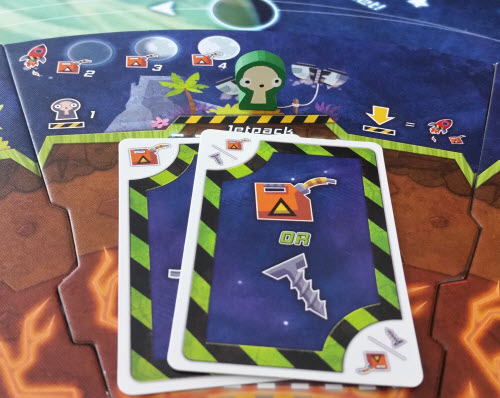
With the moon on the opposite side of the board, it only costs Green two Fuel cards to use the Jetpack and fly to safety
The game’s winner is the first player to save all of their aliens, or whoever has the most aliens when the Sun track reaches the end and the planet is destroyed. That player, having shown their knack for survival, will become the powerful new leaders of their race.
Everyone else should at least be glad they’re not Garglore bait.
Not-So-Explosive Decompression
Semi co-op games revolve around players being forced to at least partially work together, and as a mechanic it covers a wide spectrum of effectiveness. Some semi co-ops behave as regular co-ops, except that they’ll have some method of letting players backstab one another, while others behave more as a free-for-all that reward you for collaborating with your enemy.
Not only does Lift Off squarely fall into the latter category, it utilizes its semi co-op nature incredibly well. While it is technically possible to win without giving or receiving any help from your opponents, it’s far more difficult and highly unlikely for you to achieve. Most escape methods require a set number of aliens / resource cards to successfully evacuate to freedom, so unless you willingly overpay in resources to leave orbit early, you will inadvertently be aiding each other as everyone scrambles to get all of their units offworld.
Right from the onset, Lift Off has the proper mix of cooperation and selfishness. At the beginning of the game, for instance, assisting one another is less of an issue since any number of players are benefiting when the Rocket Ship or Satellite successfully activates.
As time and remaining aliens dwindle, though, Lift Off can become slightly cutthroat as you do everything in your power to ensure that you end up with the most aliens saved. This can be include swapping Lift Off tiles, using the Garglore to block players from leaving a platform, or even manipulating the moon’s orbit.
What makes Lift Off’s semi co-op implementation stand out, however, is twofold. First, the game is purposely designed so that you can scale combativeness up or down depending on your audience. The standard rules serve as a decent balance between light and competitive behavior, but the game comes with variations that allow you to make things less cutthroat (if you were playing in a more family-friendly setting), or even more so (for those who enjoy making their enemies miserable).
Yet more notably is that even with its mild antagonistic tendencies in full swing, Lift Off makes it very hard to genuinely stay annoyed when you’re slighted by another player. From the game’s central premise, to the vehicles of escape, to the aliens with their permanently-stupefied faces, Lift Off does a fantastic job feeling somewhat competitive while at the same time keeping things from ever being taken personally for more than a few seconds.
Really – you try staying mad that someone just knocked your goofy-looking alien off the trampoline.
As one would expect, because of these (and other) lighthearted Lift Off traits, expect to see Socializers willingly hop on board to save some alieneeples…and maybe hurl a Garglore or two.
Alien Construction Habits
Lift Off’s other highly admirable quality is its physical quality and composition. How a game looks and feels is key to many people over how often (or even whether) it will hit the table. That is not an issue here, as Lift Off has stellar components.
From durable cardstock to incredibly thick interlocking planet tiles, every aspect of the game’s physical pieces are exceptionally crafted and sturdy, and this is further reinforced by the rules spelling out every tile’s function. The hallmark of these components, though, are the game’s alieneeples. These wooden aliens are at the core (literally) of what makes the game so charming, and it’s hard to not want to do what you can to ensure their survival.
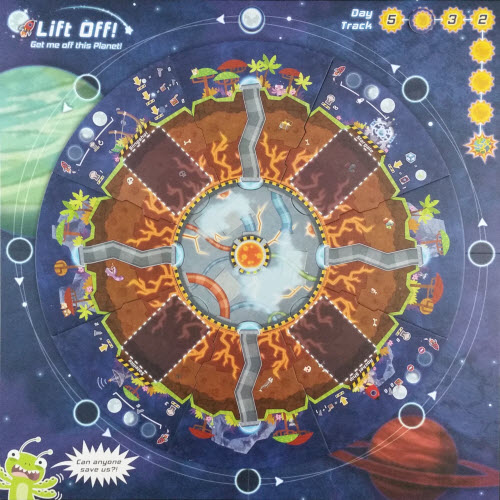 For further proof of its physical worth, take Lift Off’s main board. It isn’t even technically needed to play the game, as it’s mostly just there to hold the tile pieces, and yet it too furthers the game’s visuals. It’s evident there was an emphasis on creating a solid game across the entire breadth of its appearance, and the effort paid off handily.
For further proof of its physical worth, take Lift Off’s main board. It isn’t even technically needed to play the game, as it’s mostly just there to hold the tile pieces, and yet it too furthers the game’s visuals. It’s evident there was an emphasis on creating a solid game across the entire breadth of its appearance, and the effort paid off handily.
Lift Off is such a well put-together game, it’s almost a shame the alien’s planet wasn’t made of some of these materials. It may have had a survived a bit longer.
It’s The End Of The World And I Feel Fine
Few though they may be, Lift Off does come with a pair of small cracks in the mantle of its overall presentation.
The first is that the relative enjoyment of Lift Off and its outlandish premise is directly tied to players embracing what’s transpiring. This is a game where aliens are trying to evacuate a hollowed out planet by using, among other things, slingshots, jetpacks, and trampolines, underscoring the fact that Lift Off is not exactly a paragon of serious gameplay. Nor should it be. Lift Off works in no small part because its sprightly and playful attitude is juxtaposed against the pending explosion of an entire alien planet.
Thus, between the game’s simple rules and whimsical premise, how much entertainment you’ll get out of it is largely dependent on how resolute you are while playing. If you go into Lift Off intending for a playful end of the world escape-fest, the game comes off endearing and amusing. Lift Off asks you to get into the spirit of the situation, and the game makes it easy for Immersionists to willingly comply. If, on the other hand, you approach this game’s orbit with a more serious tone, you will quickly be left wanting an escape plan of your own. Strikers, Lift Off will not have the kind of atmosphere you’ll find desirable.
The second area giving pause is that although it doesn’t hide this fact, Lift Off is not terribly deep: the game’s complexity is about as thick as the planet’s crust. With an incredibly simple turn structure and basic ruleset, there is not a ton of hidden strategy. Moreover, much of what you’ll be able to accomplish depends on the cards you draw. Instead of heavy rules and strategy, the game prefers to keep everything simple and above the surface (except for the Garglore), largely letting the gameplay experience speak for itself.
With little need – or even capability – to plan more than a turn ahead, Lift Off doesn’t offer much in the way of long-term scheming, and Tacticians won’t be impressed by this planet’s prospects. Similarly, Architects will have mixed feelings, as aside from being able accumulate their alien survivors, the game doesn’t contain a lot of the traits they typically gravitate towards.
That being said, Lift Off isn’t a purely luck-driven game either. It avoids this by providing enough mechanical substance and player agency to let you make impacting decisions. At the same time, much of the game’s innate unpredictability lends to its appeal rather than detracts from it, and Daredevils should feel right at home throwing down cards to see whether their poor aliens can make it to the escape pods in time. What’s more, Lift Off also does a decent job keeping its replayability factor up as a casual game by offering a fair amount variability through different Lift Off tiles and card drawing. Games of Lift Off may often feel similar to one another, but they’ll never end the same way.
The Takeaway
For a game centered on evacuating from an otherworldly location, Lift Off is remarkably grounded. With a host of bright colors, durable components, and elementary rules, every aspect of the game is accessible to humans and aliens alike. It can be taught in minutes, and save for referencing the functionality of an occasional tile, there is little to trip you up. Moreover, by blending its semi co-op nature and minor player conflict with tongue-in-cheek escape methods and irrationally appealing aliens, Lift Off shows off its charm by never taking itself too seriously. Any slights against one another are quickly diffused by the audacity of the situation, making it ideal as a family or filler game. Indeed, Lift Off proves to be a wonderfully lightweight and lighthearted casual game that wears its farcical nature on its sleeve, and it’s an easy choice to beam up into a collection.
Lift Off is a product of Pencil First Games.
Cardboard Republic Snapshot Scoring (Based on scale of 5):
Artwork: 4
Rules Clarity: 4
Replay Value: 4
Physical Quality: 5
Overall Score: 4.5

